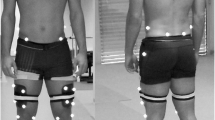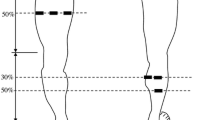Abstract
The present work seeks to provide a reliable estimation of Achilles tendon (AT) mechanical properties, especially the maximum tangent modulus (ET max) and its relationship with respect to deformation, comparing long-distance runners and pentathletes. Six pentathletes and six long-distance runners (different weekly running training volume than pentathletes (116.7 ± 13.7 vs. 58.3 ± 20.4 km, p < 0.01)). From the analysis of ET curves, it can be observed that the long-distance runners’ group presented higher ET max (380. 6 ± 92.22 vs. 36.2 ± 82.6 MPa, p < 0.05) and maximum true stress than pentathletes (24.2 ± 5.1 vs. 16.0 ± 3.5 MPa, p < 0.05). The higher AT ET max of long-distance runners suggests a higher material stiffness in the group that trains the highest weekly run volume, as well as higher AT elastic energy storage capacity. This approach can be used as a tool for evaluation and monitoring of high-performance running athletes.
Access this chapter
Tax calculation will be finalised at checkout
Purchases are for personal use only
Similar content being viewed by others
References
Ooi CC, Shneider ME, Malliaras P et al (2015) Prevalence of morphological and mechanical stiffness alterations of mid Achilles tendons in asymptomatic marathon runners before and after a competition. Skeletal Radiol 44:1119–1127. https://doi.org/10.1007/s00256-015-2132-6
Arampatzis A, Karamanidis K, Morey-Klapsing G et al (2007) Mechanical properties of the triceps surae tendon and aponeurosis in relation to intensity of sport activity. J Biomech 40(9):1946–1952. https://doi.org/10.1016/j.jbiomech.2006.09.005
Kubo K, Tabata T, Ikebukuro T et al (2010) Effects of mechanical properties of muscle and tendon on performance in long distance runners. Eur J Appl Physiol 110:507–514. https://doi.org/10.1007/s00421-010-1528-1
Tam N, Tucker R, Santos-Concejero J et al. Running economy: neuromuscular and joint stiffness contribuitions in trained runners. Int J Sport Physiol 14(1): 1–22. https://doi.org/10.1123/ijspp.2018-015
Oliveira LF, Peixinho CC, Silva GA et al (2016) In vivo passive mechanical properties estimation of Achilles tendon using ultrasound. J Biomech 49(4):507–513. https://doi.org/10.1016/j.jbiomech.2015.10.033
Pataky TC (2012) One-dimensional statistical parametric mapping in Python. Comput Method Biomec 15(3):295–301. https://doi.org/10.1080/10255842.2010.527837
Stenroth L, Cronin N J, Peltonen J et al. Triceps surae muscle-tendon properties in older endurance and sprint trained. J Appl Physiol 120(1): 63–69. https://doi.org/10.1152/japplphysiol.00511.2015
Vergari C, Pourcelot P, Holden L et al (2011) True stress and Poisson’s ratio of tendon during loading. J Biomech 44(4):719–724. https://doi.org/10.1016/j.jbiomech.2010.10.038
Daniels J (1972) Physiology of pentathlon performace. JAMA 221(9):1029–1031. https://doi.org/10.1001/jama.1972.03200220063014
Chamblin D (2015) Physical medicine and rehabilitation clinics of North America. Evidence-based treatment guidelines for treating injured workers. Foreword. Phys Med Rehabil Clin N Am 26(3): xi–xiii. https://doi.org/10.1016/j.pmr.2015.05.002
Acknowledgements
This is study was supported by CNPq, CAPES, FAPERJ and FINEP.
Conflict of Interest
The authors declare that they have no conflict of interest.
Author information
Authors and Affiliations
Corresponding author
Editor information
Editors and Affiliations
Rights and permissions
Copyright information
© 2022 Springer Nature Switzerland AG
About this paper
Cite this paper
Pinto, M.S., Sánchez, C.A.R., Brandão, M.C.A., Menegaldo, L.L., Oliveira, L.F. (2022). Achilles Tendon Tangent Moduls of Runners. In: Bastos-Filho, T.F., de Oliveira Caldeira, E.M., Frizera-Neto, A. (eds) XXVII Brazilian Congress on Biomedical Engineering. CBEB 2020. IFMBE Proceedings, vol 83. Springer, Cham. https://doi.org/10.1007/978-3-030-70601-2_78
Download citation
DOI: https://doi.org/10.1007/978-3-030-70601-2_78
Published:
Publisher Name: Springer, Cham
Print ISBN: 978-3-030-70600-5
Online ISBN: 978-3-030-70601-2
eBook Packages: EngineeringEngineering (R0)




